|

|
|
|
|
At
the age of eight, Jim knew his ABC's, could spell
and do basic math with numbers up to 30.
|
As
Jim continued his studies, the Doc taught him to tell
time, know the days of the week, and recognize flags
of different countries.
|
Over
a century ago, against the backdrop of a time in America
ripe for something to believe in, a heroic student and teacher,
together with their allies, helped heal the country struggling
to overcome the differences that constantly threatened to
separate it. The principles they exemplified matter as much
today as they did one hundred years ago, maybe more.
What
the Press & OTHERS Said about Jim Key from 1897 –
1906
“(Beautiful
Jim Key) is certainly the most astonishing and entertaining
exhibition I have ever witnessed. It is indeed a grand object
lesson of what kindness and patience will accomplish.”
–– President William McKinley (1897 Nashville
World’s Fair)
“I
cannot refrain from expressing my admiration for the marvelous
intelligence of Beautiful Jim Key. I consider him the most
accomplished specimen of his kind I have ever seen.”
–– John Philip Sousa (1897 Pittsburgh Exposition)
“Jim
Key, the learned horse . . . can do almost anything but
use articulate speech. Under the direction of his attendant
and master, William Key, who trained him, Jim added and
subtracted numbers, spelled words, told cards like a gambler,
and did many other little feats that revealed an astonishing
amount of intelligence.”
-- New York Times, December 1, 1897
“Such
a performance as Beautiful Jim Key goes through with has
never been equaled by any horse in this vicinity.”
–– New York Sun
“Almost
all things seem possible to Beautiful Jim Key, except the
power of speech. So perfectly is this wonderful horse trained
that the trainer does not touch him with hand or whip.”
–– New York Herald
“This
educated horse is undoubtedly the most intelligent horse
in the world. We have never had any that could begin to
do what he so easily does. Nor have I ever seen any such
exhibition, though I have witnessed the performance of every
trained horse on both continents.”
–– Pittsburgh Commercial Gazette
“Speech
alone is denied to Jim Key, the most intelligent horse that
ever looked through a bridle or munched oats, but he makes
himself as clearly understood as the most accomplished linguist.”
–– Cincinnati Commercial Gazette
“Horse,
the pupil, and man, teacher, have been in nearly all the
large cities of the country, and in many of them the schools
have been dismissed for the day to permit the children to
see a horse who can ring up a telephone as easily as he
can trot a mile.”
–– Boston Globe
“The
soul of a gentleman and scholar inhabits the Beautiful body
of wonderful Jim Key. . . to demonstrate . . . that animals
reason and think . . . (and) goes to prove that Jim does
possess a soul.”
–– Atlanta Constitution
“Suppose
our boys and girls were all trained as Jim Key has been
trained; suppose they were given education as fitted their
needs and capacity.”
–– Omaha World Herald
“(Jim
Key performs) with a consistency that lives up to his claim
of being the best educated horse in the world.”
-- Minneapolis Journal
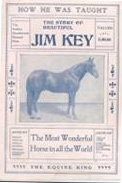 ALBERT
ROGERS & DR. WILLIAM KEY CO-AUTHORED JIM’S OWN
BESTSELLER – Reprinted & revised into 12 editions
and SELLING ALMOST 300,000 COPIES ALBERT
ROGERS & DR. WILLIAM KEY CO-AUTHORED JIM’S OWN
BESTSELLER – Reprinted & revised into 12 editions
and SELLING ALMOST 300,000 COPIES
Originally
subtitled, “HE WAS TAUGHT BY KINDNESS,” the magical,
romantic yet true story of how the ugly duckling misfit
foal became the tall, strapping BEAUTIFUL JIM KEY –-
whose  academic
abilities were equal to those of a human sixth grader -–
includes glimpses into the lost history more fully uncovered
by Rivas’s book and the upcoming documentary and feature
film: academic
abilities were equal to those of a human sixth grader -–
includes glimpses into the lost history more fully uncovered
by Rivas’s book and the upcoming documentary and feature
film:
Jim’s
BIG BREAK in 1897, when he was discovered by none other
than William McKinley, the President of the United States,
at the Tennessee Centennial & World’s Fair.
|
|
|
How
his value rose from less than 500 dollars as a five
year old to one million when he became the top-selling
attraction at the St. Louis World's Fair/Louisiana
Purchase Exposition: The Wonder of the Pike
|
The
Silver Horseshoe Building on the Pike at The Louisiana
Purchase Exposition 1904
|
 An
interview with Dr. William Key, with a biographical sketch
of his life: the talents he displayed even as a child for
horse and mule taming, only with kindness, rumors of occult
abilities, the slave driver who once swore to murder him
as a child, how he chose to protect his master’s sons
of the side of the Confederacy, also helping Union soldiers
and fellow slaves to escape along the Underground Railroad,
the famous Civil War Battles in which he participate, building
his own Fort Bill in one early battle, returning with enough
poker winnings to launch many businesses, including the
highly successful Keystone Liniment which allowed him to
help his former master’s widow pay off her mortgage. An
interview with Dr. William Key, with a biographical sketch
of his life: the talents he displayed even as a child for
horse and mule taming, only with kindness, rumors of occult
abilities, the slave driver who once swore to murder him
as a child, how he chose to protect his master’s sons
of the side of the Confederacy, also helping Union soldiers
and fellow slaves to escape along the Underground Railroad,
the famous Civil War Battles in which he participate, building
his own Fort Bill in one early battle, returning with enough
poker winnings to launch many businesses, including the
highly successful Keystone Liniment which allowed him to
help his former master’s widow pay off her mortgage.
The brochure details Jim’s fine breeding: by Tennessee
Volunteer, his heralded sire, a Hambletonian, out of the
legendary dam, Lauretta Queen of Horses, a pure Arabian,
stolen from a Persian Sheik by an agent of P.T. Barnum,
exhibited in Europe, abused and neglected, brought to America
(photo above is Key with a young A.R. Rogers) and bought
by the Doc for forty dollars at a circus auction. And Key’s
efforts, opening up his own racetrack in Tennessee, to create
that perfect match.
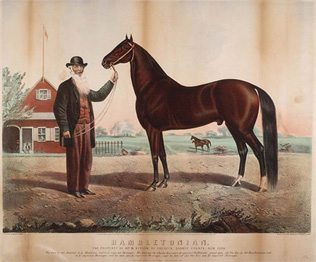
RYSDYK’s HAMBLETONIAN, the cornerstone of the STANDARD-BRED,
Jim’s great-great grandsire.
Rogers
& Key describe how the colt with the finest pedigree
in the country turned out to be neither a racehorse nor
a showhorse. In fact, when he was foaled in 1889 in Shelbyville,
Tennessee, he was so sickly and crippled that his owner,
Dr. William Key, hardly expected the ugly duckling of a
scrub-colt to live. Instead of naming him for a biblical
prophet as he had planned, he chose “Jim” after
a wobbly local drunk, but gave him his own last name. But
not giving up on him, after treating him with his own medicines,
the Doc watched as the misfit colt eventually transformed
into a gorgeous mahogany bay.
By the time of Jim’s foaling, the self-taught, entrepreneurial
Dr. Key’s businesses included a leading veterinary
practice, a racetrack, hotel, restaurant, with his fortune
made from his patent medicine Keystone Liniment that he
sold in his traveling medicine shows. Though he was eventually
married to four notably beautiful, educated women, Dr. Key
had no children of his own.
In narrating Jim’s unique education, the Doc notes
that he was already fifty-six years old when the sickly
Jim was foaled. When his dam died, the orphaned colt refused
to be separated from his owner and trainer, causing such
a ruckus in the barn that Dr. Key was forced to take the
colt into his home. For the first year of his life, Jim
lived as a human, absorbing language and abstract concepts
to a staggering degree. When he outgrew the house and moved
back to the stables, William Key had to set up a cot out
there. The two were inseparable companions and partners
from then on.
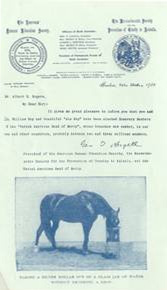 BEAUTIFUL
JIM KEY’s showstopper was the act of retrieving a silver
dollar from a barrel of water, not drinking a drop. BEAUTIFUL
JIM KEY’s showstopper was the act of retrieving a silver
dollar from a barrel of water, not drinking a drop.
Traveling
and performing with Dr. Key and his medicine show for the
next seven years, Jim became a seasoned thespian. The Doc
began his serious tutelage of Jim on a whim, thinking he
would teach him only one letter of the alphabet, then another,
then the rest. Over seven years, he used kindness, patience
and rewards to teach Jim to read, spell, recognize money,
and do basic arithmetic.
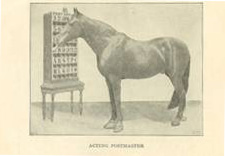 |
|
Jim
plays postmaster
|
As
a horse who paved the way for all Equine and human superstars,
setting the stage for the likes of Seabiscuit and even Elvis
Presley, the Celebrated Education Hambletonian Arabian’s
lavish lifestyle is further described: His luxurious stables,
his bodyguard Monk, his tutors and valets, the private train
cars he traveled in, purified water and special hay supplied
to him, his appreciation for applause and laughter, not
to mention the endless gifts and tributes being sent to
him by fans, and his love for teaching people to be kind
to animals.
|
|
|
Jim
and his “constant companion”, Monk
|
Jim
Key picks up his fan mail
|
Specifics
are provided, backing up the claim that he earned the highest
box office receipts in venues across much of the nation,
outselling the highest grossing human competitors. Experts
opinions, testimonials, and endorsements are listed, together
with the results of a Harvard Study that concluded his abilities
were the result not of a hoax or hypnosis, but of “simply
education.”
|
|
|
|
“I
HAVE SEEN JIM KEY” button
|
Far
ahead of his time, Albert R. Rogers pioneered celebrity
endorsement advertising deals & Doc Key tapped
his connections to obtain licensing for Beautiful
Jim Key
|
THE
SOCIETY HORSE had his own line of OFFICE equipment |
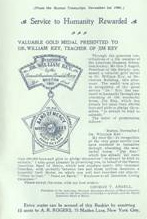 The
POWER OF KINDNESS to challenge prejudices, promote peace,
literacy, non-violence, and a recognition of our connections
that transcend race and species are evident in the mere
sampling of the numerous awards and recognition bestowed
on the The
POWER OF KINDNESS to challenge prejudices, promote peace,
literacy, non-violence, and a recognition of our connections
that transcend race and species are evident in the mere
sampling of the numerous awards and recognition bestowed
on the  heroes:
from William Key becoming the 1st AFRICAN-AMERICAN RECIPIENT
OF MSPCA’S HUMANITARIAN GOLD MEDAL to Jim’s being
the 1st NON-HUMAN RECIPIENT OF NUMEROUS HUMANE & LITERACY
AWARDS. heroes:
from William Key becoming the 1st AFRICAN-AMERICAN RECIPIENT
OF MSPCA’S HUMANITARIAN GOLD MEDAL to Jim’s being
the 1st NON-HUMAN RECIPIENT OF NUMEROUS HUMANE & LITERACY
AWARDS.
ALBERT ROGERS’s estate, “Glenmere” in South
Orange, New Jersey – Beautiful Jim Key’s “second
home”
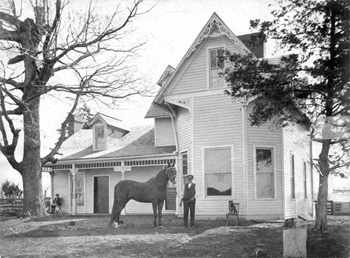
Not
long after their retirement in 1906, Monk, Jim and the Doc
retired to their home in Shelbyville, where all three are
buried today. Of their many contributions, perhaps the most
unsung is that of William Key’s transformational impact
on Black History, acknowledged in the following review of
BEAUTIFUL JIM KEY by Mim Eichler Rivas:
From
BOOKPAGE, February Black History Month Review 2005
by Ed Hotaling.
Beautiful
Jim Key: The Lost History of a Horse and a Man Who Changed
the World also documents an animal-based story,
but quite a different one. Mim Eichler Rivas spotlights
Beautiful Jim Key, a horse whose intelligence and ability
paved the way for a new appreciation of horses and all other
animals as well. Key's owner and trainer was Dr. William
Key of Shelbyville, Tennessee, an ex-slave who was also
a veterinarian and entrepreneur. Dr. Key eschewed cruelty
and the use of force, preferring to use kind words, a gentle
touch and a calm, almost reverent demeanor toward his horse.
Dr.
Key became a celebrated figure in his own right, a famous
black American who wasn't an entertainer, athlete or activist.
His stately, dignified and educated image and the results
of his training made him a quiet hero during a time long
before the civil rights era. He traveled with his horse
to places where he was regarded as something below the animal
he was presenting, yet his openness, kindness with Jim Key
and overall attitude often softened the hearts of those
who would otherwise oppose him solely due to his race. Beautiful
Jim Key contains some striking descriptions of the horse's
maneuvers and performance moves, as well as a poignant account
of an amazing relationship between owner/trainer and animal
that in a small but significant way helped make a difference
socially during the early part of the 20th century.
|
![]()
![]() The
official Site for Beautiful Jim Key, and the book by Mim Eichler Rivas. All
material © 2007.
The
official Site for Beautiful Jim Key, and the book by Mim Eichler Rivas. All
material © 2007.